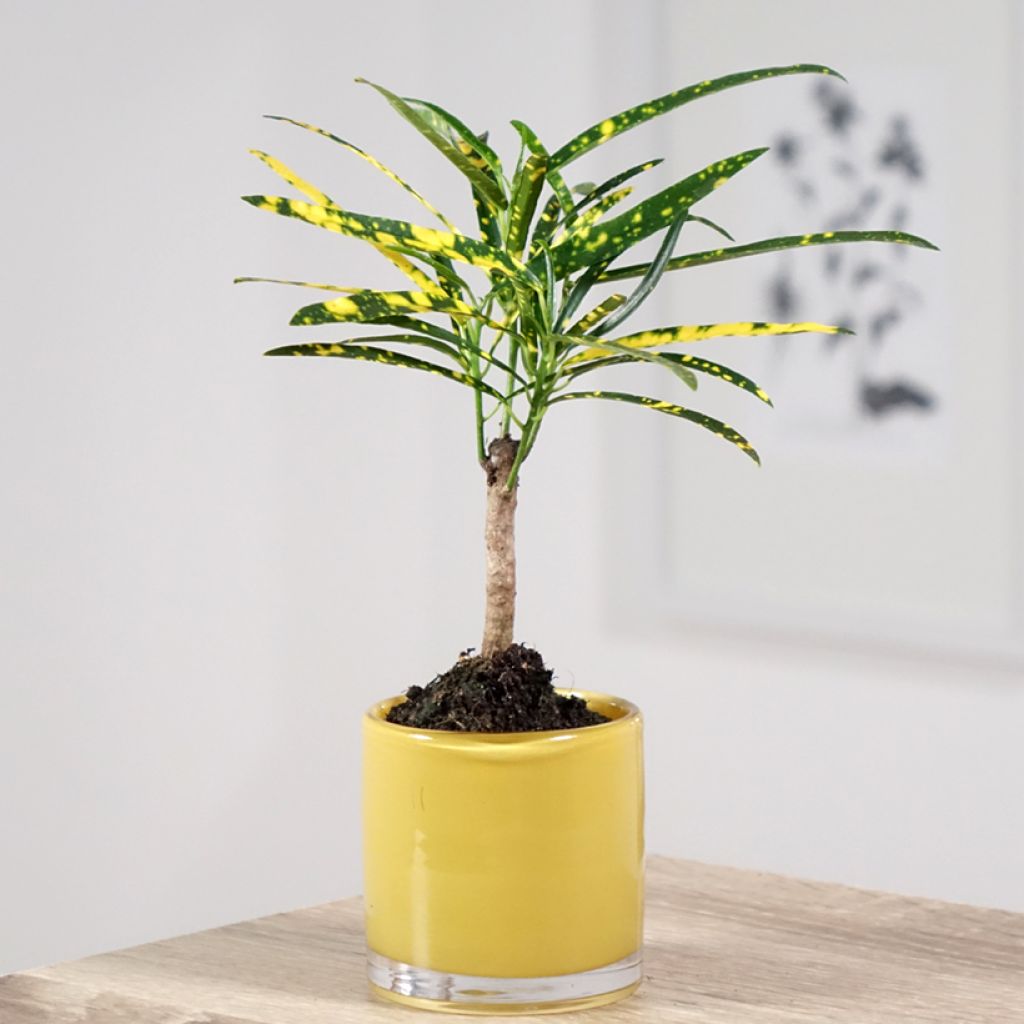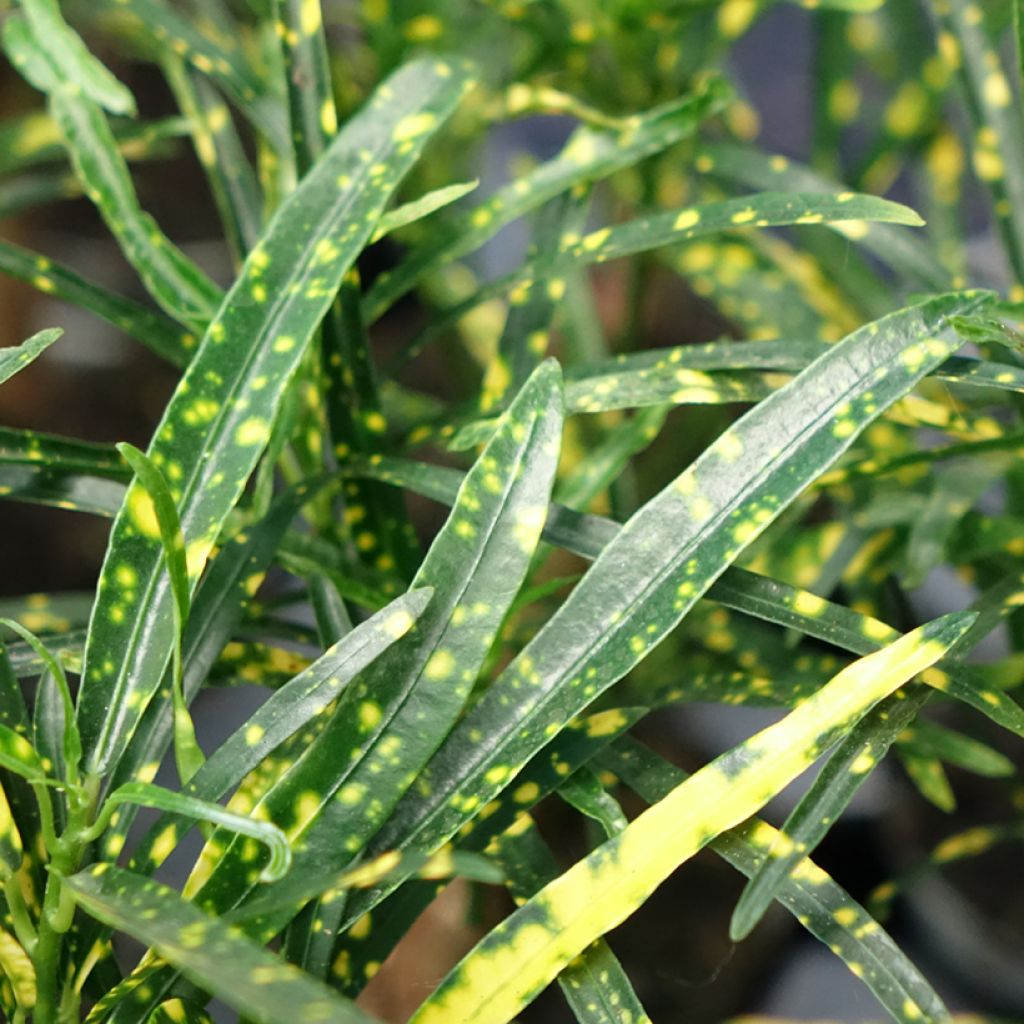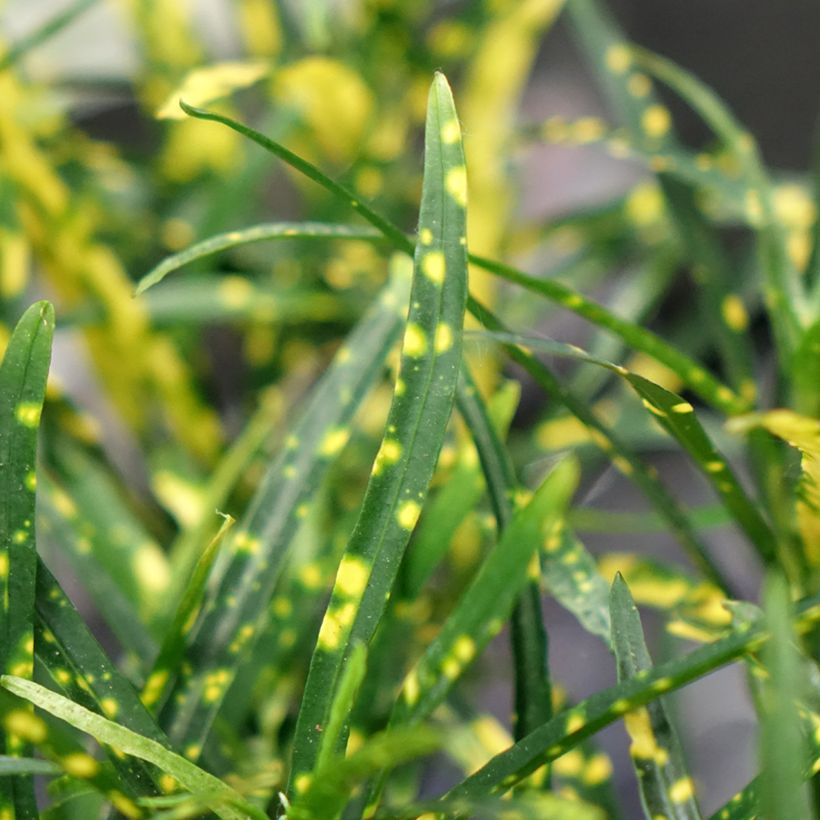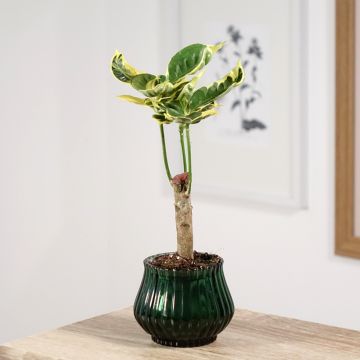

Croton - Codiaeum variegatum var. pictum


Croton - Codiaeum variegatum var. pictum
Croton - Codiaeum variegatum var. pictum
Codiaeum variegatum var. pictum
Croton, sun-spot croton
This item cannot be shipped to the selected country
Delivery charge from €6.90
More information
Schedule delivery date,
and select date in basket
This plant carries a 30 days recovery warranty
More information
We guarantee the quality of our plants for a full growing cycle, and will replace at our expense any plant that fails to recover under normal climatic and planting conditions.
From €7.90 for pickup delivery and €6.90 for home delivery
Express home delivery from €8.90.
Description
The Croton Pictum (Codiaeum variegatum var. pictum), with its variegated foliage blending shades of green, yellow, red, and orange, is impossible to ignore. This exotic houseplant adds a fantastic tropical touch to your décor, fitting seamlessly into contemporary or bohemian interiors. To preserve the intensity of its colours, place it in a bright spot away from direct sunlight and maintain good ambient humidity by regularly misting its leaves. Also, be sure to avoid draughts and sudden temperature changes.
The Croton Pictum or Croton variegatum, also known by the Latin names Codiaeum variegatum var. pictum or Codiaeum variegatum var. variegatum, is a perennial bushy plant from the Euphorbiaceae family, prized for its highly ornamental foliage. The alternate, thick, leathery leaves display an often variegated diversity of shapes—elliptical, lanceolate, or ribbon-like—and a vibrant colour palette, including green, yellow, red, purple, bronze, and pink. Indoors, its growth is moderate, reaching a height of 60 cm to 1 m with a spread of 30 to 60 cm. Its habit is upright and compact, forming a dense-leaved bush. Flowering, though rare in indoor cultivation, produces insignificant small white male flowers and yellowish female flowers, arranged in terminal or axillary inflorescences.
Native to the open forests of Malaysia and the islands of the eastern Pacific, the Codiaeum variegatum thrives in humid tropical environments. In its natural habitat, it grows under forest cover, benefiting from filtered light and constant humidity.
As a houseplant, the Croton 'Pictum' requires bright light without direct sun to maintain its vibrant colours, as well as high ambient humidity ideally between 60% and 80%. The temperature should range between 18°C and 25°C, and the plant dislikes draughts and sudden temperature fluctuations.
Warning - The Croton is toxic to humans and pets, particularly if its leaves are ingested or if its sap comes into contact with the skin, which may cause irritation.
The Croton 'Pictum', with its multicoloured foliage, is perfect for brightening up a living room, conservatory, or even an office. Its exotic style fits beautifully into modern, bohemian, or tropical décors, where it adds life and a warm atmosphere. Place it in a minimalist ceramic pot for a contemporary look or in a wicker planter for a more natural effect. On a well-lit shelf or as a standalone piece near an east- or west-facing window, it will form an elegant focal point.
To create a harmonious display, pair the Croton 'Pictum' with a Ficus elastica 'Tineke', whose variegated leaves contrast beautifully with its fiery hues, or a Philodendron 'Brasil', with green leaves splashed with yellow.
Report an error about the product description
Croton - Codiaeum variegatum var. pictum in pictures


Foliage
Plant habit
Flowering
Botanical data
Codiaeum
variegatum var. pictum
Euphorbiaceae
Croton, sun-spot croton
Southeast Asia
Safety measures
Other Croton - Codiaeum
View all →Location
Location
Maintenance and care
Potting advice, substrates and fertilisers
Houseplant care
Disease and pest advice
Maintenance and care
This item has not been reviewed yet - be the first to leave a review about it.
Haven't found what you were looking for?
Hardiness is the lowest winter temperature a plant can endure without suffering serious damage or even dying. However, hardiness is affected by location (a sheltered area, such as a patio), protection (winter cover) and soil type (hardiness is improved by well-drained soil).

Photo Sharing Terms & Conditions
In order to encourage gardeners to interact and share their experiences, Promesse de fleurs offers various media enabling content to be uploaded onto its Site - in particular via the ‘Photo sharing’ module.
The User agrees to refrain from:
- Posting any content that is illegal, prejudicial, insulting, racist, inciteful to hatred, revisionist, contrary to public decency, that infringes on privacy or on the privacy rights of third parties, in particular the publicity rights of persons and goods, intellectual property rights, or the right to privacy.
- Submitting content on behalf of a third party;
- Impersonate the identity of a third party and/or publish any personal information about a third party;
In general, the User undertakes to refrain from any unethical behaviour.
All Content (in particular text, comments, files, images, photos, videos, creative works, etc.), which may be subject to property or intellectual property rights, image or other private rights, shall remain the property of the User, subject to the limited rights granted by the terms of the licence granted by Promesse de fleurs as stated below. Users are at liberty to publish or not to publish such Content on the Site, notably via the ‘Photo Sharing’ facility, and accept that this Content shall be made public and freely accessible, notably on the Internet.
Users further acknowledge, undertake to have ,and guarantee that they hold all necessary rights and permissions to publish such material on the Site, in particular with regard to the legislation in force pertaining to any privacy, property, intellectual property, image, or contractual rights, or rights of any other nature. By publishing such Content on the Site, Users acknowledge accepting full liability as publishers of the Content within the meaning of the law, and grant Promesse de fleurs, free of charge, an inclusive, worldwide licence for the said Content for the entire duration of its publication, including all reproduction, representation, up/downloading, displaying, performing, transmission, and storage rights.
Users also grant permission for their name to be linked to the Content and accept that this link may not always be made available.
By engaging in posting material, Users consent to their Content becoming automatically accessible on the Internet, in particular on other sites and/or blogs and/or web pages of the Promesse de fleurs site, including in particular social pages and the Promesse de fleurs catalogue.
Users may secure the removal of entrusted content free of charge by issuing a simple request via our contact form.
The flowering period indicated on our website applies to countries and regions located in USDA zone 8 (France, the United Kingdom, Ireland, the Netherlands, etc.)
It will vary according to where you live:
- In zones 9 to 10 (Italy, Spain, Greece, etc.), flowering will occur about 2 to 4 weeks earlier.
- In zones 6 to 7 (Germany, Poland, Slovenia, and lower mountainous regions), flowering will be delayed by 2 to 3 weeks.
- In zone 5 (Central Europe, Scandinavia), blooming will be delayed by 3 to 5 weeks.
In temperate climates, pruning of spring-flowering shrubs (forsythia, spireas, etc.) should be done just after flowering.
Pruning of summer-flowering shrubs (Indian Lilac, Perovskia, etc.) can be done in winter or spring.
In cold regions as well as with frost-sensitive plants, avoid pruning too early when severe frosts may still occur.
The planting period indicated on our website applies to countries and regions located in USDA zone 8 (France, United Kingdom, Ireland, Netherlands).
It will vary according to where you live:
- In Mediterranean zones (Marseille, Madrid, Milan, etc.), autumn and winter are the best planting periods.
- In continental zones (Strasbourg, Munich, Vienna, etc.), delay planting by 2 to 3 weeks in spring and bring it forward by 2 to 4 weeks in autumn.
- In mountainous regions (the Alps, Pyrenees, Carpathians, etc.), it is best to plant in late spring (May-June) or late summer (August-September).
The harvesting period indicated on our website applies to countries and regions in USDA zone 8 (France, England, Ireland, the Netherlands).
In colder areas (Scandinavia, Poland, Austria...) fruit and vegetable harvests are likely to be delayed by 3-4 weeks.
In warmer areas (Italy, Spain, Greece, etc.), harvesting will probably take place earlier, depending on weather conditions.
The sowing periods indicated on our website apply to countries and regions within USDA Zone 8 (France, UK, Ireland, Netherlands).
In colder areas (Scandinavia, Poland, Austria...), delay any outdoor sowing by 3-4 weeks, or sow under glass.
In warmer climes (Italy, Spain, Greece, etc.), bring outdoor sowing forward by a few weeks.

































